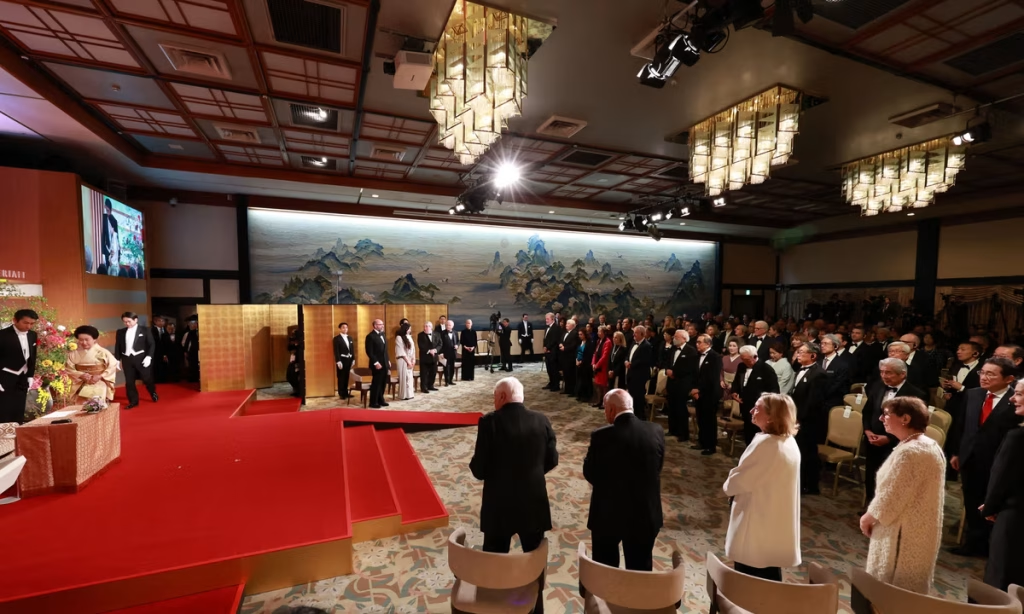The artists Peter Doig and Marina Abramović were honoured at a star-studded ceremony in Tokyo yesterday, celebrating them as the recipients of this year’s Praemium Imperiale Awards, known as the “Nobel Prize for the Arts”.
At the ceremony, hosted by the Japan Arts Association and held in the 19th century Meiji Kinenkan hall, Princess Hitachi, a member of the Japanese imperial family, presented the laureates with gold medals. This year’s laureates, who were first named in July, are Doig (painting), Abramović (sculpture), Eduardo Souto de Moura (architecture), András Schiff (music), and Anne Teresa De Keersmaeker (theatre/film). As well as a medal, each received 15 million Yen (£77,000).
Attendees at the event included Praemium Imperiale’s international advisors: former US secretary of state Hillary Rodham Clinton, Lord Patten of Barnes, the former governor of Hong Kong and ex-Italian prime minister Lamberto Dini. Also present were previous laureates including the artists Hiroshi Sugimoto and Lee Ufan.
In her speech, Clinton quoted American playwright Robert Wilson, stating: “Artists are the diarists and journalists of the days in which we live. Politics and religion will always separate us but art has the possibility of bringing us together.”
She continued: “Today his words resonate even more deeply. We live in an age of noise and division. And we recognise art is not just for beauty or entertainment but it serves a central role in our society and in the common human experience. It is a powerful vehicle for diverse ideas and expressions that inspire us, challenge us and heal us.”
Also speaking at the ceremony, Dini warned that more needs to be done to support art education. “The educational systems around the world are increasingly designed, first and foremost, to provide the skills required by industries and employers, by the economy,” he said. “As a result, the number of schools that offer creative art teaching, history of art, painting, music and drama, is declining sharply, and thus the basin of art students is shrinking.”
Doig, born in Edinburgh, is known for his dreamlike figurative paintings. He was a leading figure in the New Figurative Painting movement and was nominated for the Turner Prize in 1994. His previous accolades include the 1993 John Moores Painting Prize, and the Wolfgang Hahn Prize, which he won in 2008.
He has held exhibitions at institutions including Tate Britain (2008), the Fondation Beyeler in Switzerland (2014-5) and the National Museum of Modern Art in Tokyo (2020). His latest exhibition, Peter Doig: House of Music, opened earlier this month at the Serpentine South Gallery, London.
Marina Abramović, born in Belgrade, is famous for her provocative performances exploring audience interaction. Her video installation Balkan Baroque—which depicts her vigorously scrubbing thousands of bloody cow bones over a period of four days, in a reference to the ethnic cleansing that had taken place in the Balkans during the 1990s—earned her the Golden Lion at the 1997 Venice Biennale.
Abramović said in a statement: “Sometimes I give birth to my art and sometimes it gives energy to my life. Sometimes it just appears in front of me like a three-dimensional vision.
“Whatever way it manifests itself, I always ask myself: Am I afraid of this or do I like it? If I like it, I am not interested—I’m not after comfortable ideas. I am only interested in ideas that deeply disturb me—ideas that I am afraid of and [are] difficult to realise.”
The architecture laureate de Moura has a portfolio that includes the Braga football stadium, Portugal’s Paula Rego Museum and the 2005 Serpentine Pavilion. A statement from Praemium Imperiale recognised his use of materials, in particular granite, wood, marble, brick, steel and concrete, as well as his “unexpected use of colour”.
